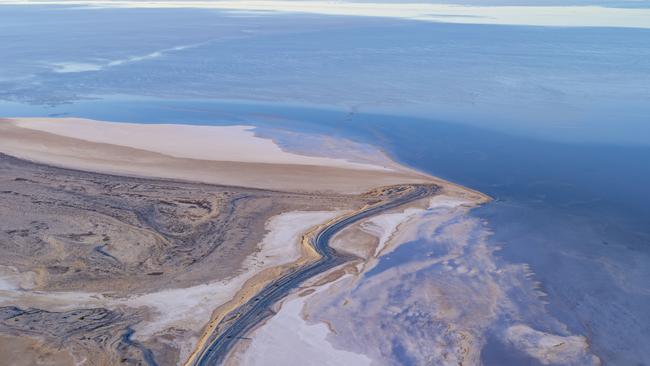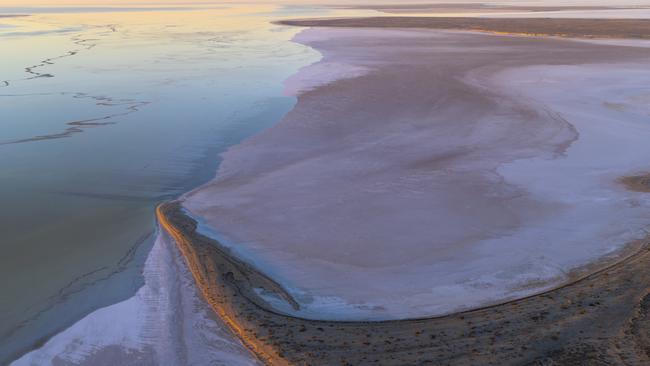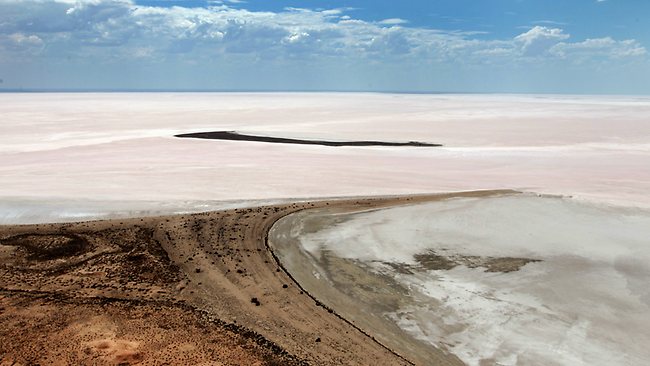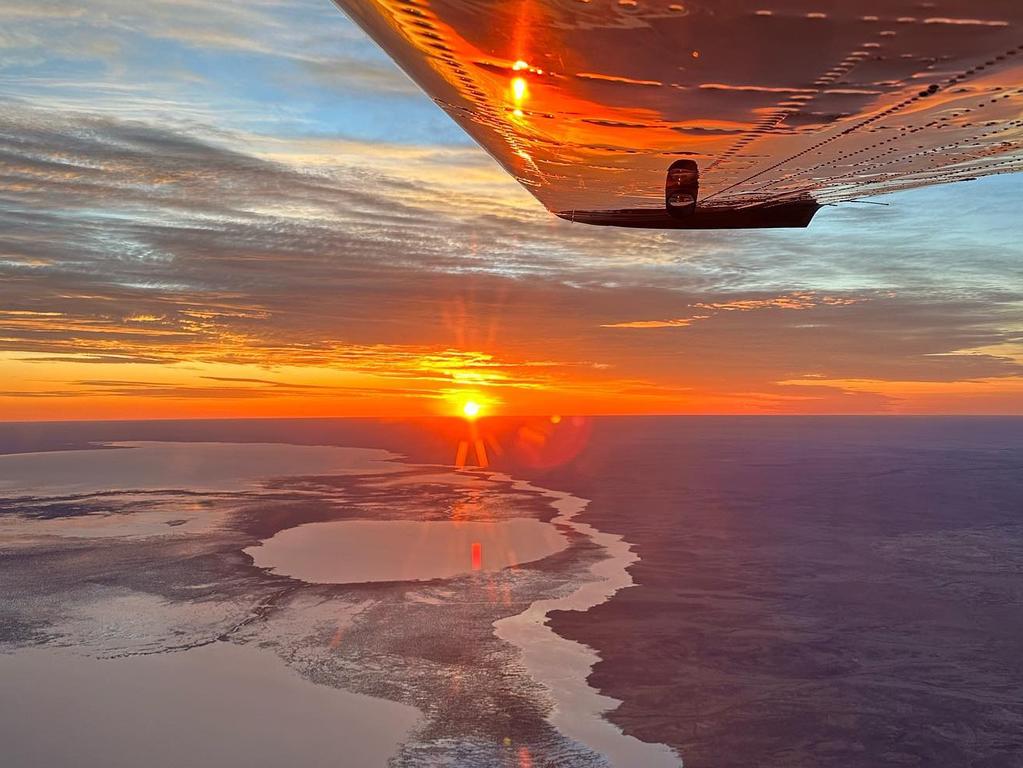Kati Thanda-Lake Eyre comes alive as floodwaters turn the desert green
Only in Australia: Kati Thanda-Lake Eyre has been transformed into a sea of hope while floods and drought unleash devastation and despair on other corners of the country.

The flood was raised months ago in a distant northern catchment and now it’s here, bursting with the promise of new life, spreading across the pearly expanse of Kati Thanda-Lake Eyre.
Australia’s dead heart? Forget that. The desert is in full, exuberant bloom as the vast saltpan fills with chocolatey water teeming with microcrustaceans and newly hatched fish. The sky is thick with birds feasting on the bounty.
This gift from the heavens is the flipside of the heartache that rained down on towns and stock runs across Queensland’s remote Channel Country in March. Hundreds of homes and homesteads were destroyed while livestock in the hundreds of thousands perished in the deluge spawned by Tropical Cyclone Alfred, a $1bn-plus disaster for the region.
Now, verdant green shoots are emerging wherever the great, ephemeral inland rivers run. Only in Australia could this happen at a time when communities on NSW’s Mid North Coast and in the Hunter Valley have been devastated by floods that killed at least four people this week and as immense tracts of South Australia, Victoria, Tasmania and the top end of West Australia stay crushingly dry.
Talk about a land of drought and flooding rains.
At Nana Glen near Coffs Harbour, NSW police said the body of a man in his 70s was found inside a submerged car, taking the known death toll to four. About 9000 people were under evacuation orders and an estimated 50,000 remained isolated in towns or homes cut off by floodwaters.
And in drought-hit areas, farmers are demanding a dramatic scale-up of emergency assistance as the dry conditions stretch to a second or even third year in southeastern Australia.
What a contrast to the season of plenty unfolding in the nation’s most far-flung national park at Kati Thanda-Lake Eyre – 697km north of Adelaide, 1400km from Sydney as the pelican flies – where the sun-blasted wastes have turned lush in an explosion of new life.

Water, water everywhere. The floodtide is backed up for hundreds of kilometres beyond the blanched horizon. Its leading edge is advancing across the salt-encrusted lake bed at a brisk walking pace, and began emptying into the deep end at Belt Bay on Monday.
The experts are divided on how big the drink will be. The benchmark is a succession of floods in the mid-1970s that filled the lake to a depth of nearly 6m, the last time it was brimming.
The word is this one will top 2.5m to surpass the next-best result recorded in 2011.
“No one really knows what to expect,” said Richard Kingsford, the director of the University of NSW’s Centre for Ecosystem Science who is an expert on the Lake Eyre Basin. “It’s certainly a big flood, one of the biggest we’ve had for 20 or 30 years, but it’s a question of how much of the water coming down the river systems from Queensland ends up going the distance. Obviously, it’s got a fair bit of push at the moment.”
You can say that again. The amount of water pulsing through the spider’s web of creeks and rivers skirting the Simpson Desert and draining to Kati Thanda is staggering. Bob Backway, the commodore of the Lake Eyre Yacht Club – yes, really – said upward of 4000 gigalitres was set to pour in, more than seven times the volume of Sydney Harbour.
Preparing to launch a 4m Caper Cat sailboat with a trio of friends on pumping Warburton Creek, the main channel feeding into the lake, Mr Backway told The Australian: “I’d say we’re looking at around 2.5m of water through the lake as a whole, and that would make it the biggest flood since 1989.”
The transformation is magical, the crowning expression of dust-to-boom renewal in an ancient but ever-changing land. For years, plants, insects and microfauna have lain dormant in the baking lake bed and surrounds waiting for the flood to come. Add Eyre and water and hey presto: the first link in an elaborate food chain is forged.
The size of the flood is key. “It’s a threshold thing,” Professor Kingsford explained. “You’ve got to get enough freshwater in to let the biology really take off; you won’t get the full effect if there’s too much salt in the lakewater. So, you know, that first flush of water is pretty saline because it dissolves all the salt crystals in the crust. The more freshwater you get in, the more it becomes a friendlier environment for different invertebrates and once they are in there, the fish will come.”

Pink-eared ducks are among the first birds to arrive, using their sieved beaks to feed on the tiny prawn-like crustaceans emerging in the billions. The Pacific heron and straw-necked ibis aren’t far behind. When the majestic pelicans fly in from the coast, you know something big is stirring.
By then, the aquatic macrophytes – water lilies and sedges – will be crowding the banks of the waterholes and waterways leading onto the lake, providing another source of food. The fish stocks will be boosted by 50cm-long golden perch and the Lake Eyre hardyhead, a salt-tolerant freshwater silverside.
“Floods are always fantastic,” said Professor Kingsford, who has spent most of his adult life studying them. “You just see the magnificence and beauty of the Australian interior come forth in them. The water produces this amazing magic in the environment … it sort of explodes into life in all its dimensions.
“For a biologist, it’s actually a bit overwhelming … you want to look at everything but unfortunately you have got only a short amount of time to work, so you can never ever be really satisfied.”
The locals, in the know about how the inland river systems run, are watching the water roll in. The Georgina and Diamantina rivers are in full flood from rain that has taken months to work its way down from northwest and centralwest Queensland, respectively. These fabled outback waterways converge at Goyder Lagoon, a 100km-long swamp above the lake. The Warburton River funnels the churning flood onto its final destination, stirred by rapids and whirlpools.
The Thomson and Barcoo rivers feed Cooper Creek, further to the east. When the Cooper flows strongly, as it is set to, water will spill from Belt Bay 15m below sea level into Madigan Gulf, the flats where British daredevil Donald Campbell broke the world land speed record in 1964, pushing the Bluebird to 403m/hr (648km/hr).
Graziers near and far are licking their lips at the coming season. Birdsville-based David Brook, who owns a string of cattle stations reaching from far southwest Queensland into South Australia’s arid top end, said: “There’s a lot of smiles around. A lot of flies, too.”
At William Creek, the nearest accommodation centre to the lake, bush pilot Trevor Wright has put on 11 extra staff to handle the influx of tourists as well as more pilots for his fleet of 11 sightseeing planes. He’s busy as can be, and grateful for it after a series of drought-hit seasons. “From the air this flood is amazing,” he said on Friday. “Goyder Lagoon is just huge and that water hasn’t drained yet. I’ve been out here for 32 years, and I haven’t seen anything as big as this.”








To join the conversation, please log in. Don't have an account? Register
Join the conversation, you are commenting as Logout